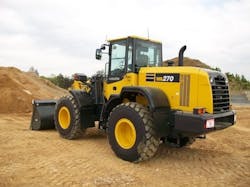Komatsu WA270-7 Wheel Loader With Parallel Z-Bar
The 149-horsepower WA270-7 wheel loader, which replaces the WA250-6 and WA250PZ-6, has a Tier 4-Interim Komatsu SAA6D107E-2 engine that decreases fuel consumption by as much as 10 percent. Weighing in at 28,836 pounds, the WA270-7 features Komatsu’s parallel Z-bar (PZ) loader linkage. Komatsu’s SmartLoader Logic, a control system that provides optimal engine torque for specific operating situations, automatically decreases torque in low-load applications and saves fuel. Increased cooling capacity and a standard auto-reversing fan are aimed at overall enhanced temperature control. The WA270-7 features Komatsu’s third-generation hydrostatic drive train, which has increased pump capacity. The dynamic-braking effect of the drive train slows the machine when the accelerator is released, virtually eliminating brake wear, says the company, and enhancing overall machine control. The electronically controlled drive train also features Komatsu’s two-mode traction control system, designed to facilitate operation in soft or slippery ground. For ground-speed control, the WA270-7’s variable-speed-control feature allows setting a maximum speed (up to 8.1 mph) or if slower speeds are more suitable, the “creeping” range limits speed to 2.5 mph.
For improved visibility, the loader’s front glass has been lowered, and the dashboard redesigned. Also redesigned is the seat-mounted, right-hand console that has a multifunction mono-lever with proportional control for the integrated third spool. A high-resolution, 7-inch LCD monitor features enhanced capabilities and allows setting parameters for features such as auto-idle shutdown and the auto-reversing fan. A high-resolution back-up camera uses a separate monitor on the right console.
Komatsu CARE is complimentary for three years or 2,000 hours (whichever occurs first). Also included are two complimentary particulate filter exchanges at 4,500 hours and 9,000 hours within the first five years.
The Komatsu EMMS (Equipment Management Monitoring System) provides enhanced diagnostic features and continuously monitors critical systems.
